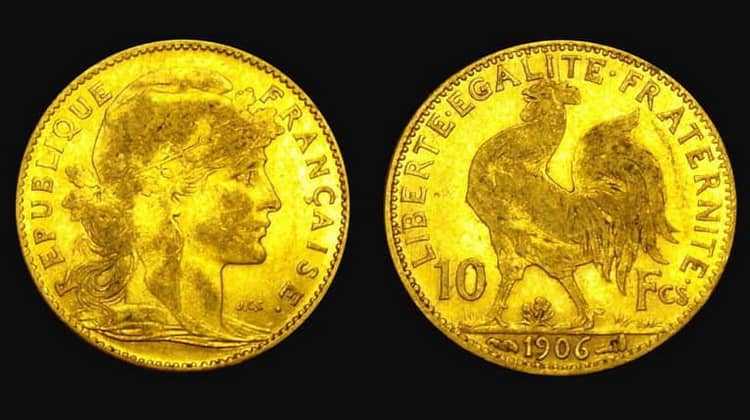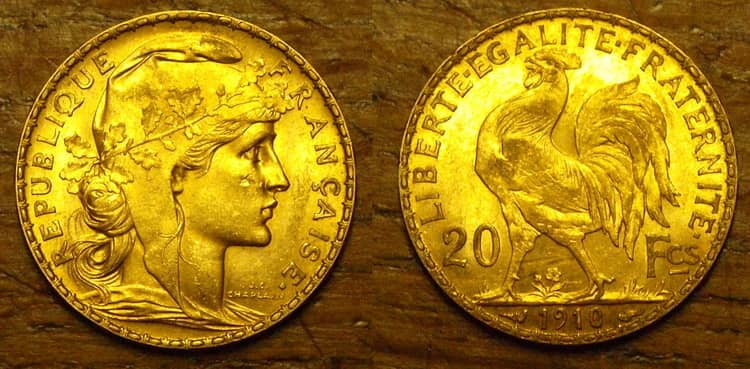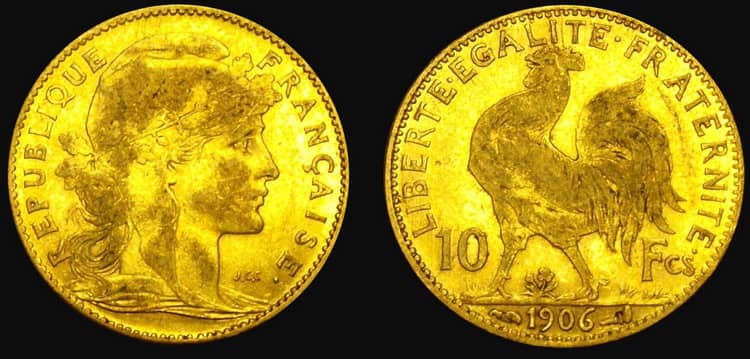
The 20 francs of the “Rooster” series (1899-1914) are gold coins of high quality minted during the French Third Republic. The “Roosters” as well as the famous “Angels”, which were minted before, are a part of a vast family of “Napoleon coins” − coins issued since the beginning of the country’s gold standard, introduced by Napoleon Bonaparte. Gold coins of this series are among the most desirable on the numismatic market, and surviving samples of the first circulations have become the object of interest for collectors around the world.
Characteristic of coins
Years of Issue: 1899-1914.
Material: Gold .900.
Diameter: 21 mm.
Thickness: 1.25 mm.
Weight: 6,45161 g.
The edge: from 1899 to 1906, the inscription “Dieu protège la France” (God save France) was minted on the edge, and on the 1906-1914 edition it was replaced by the line “Liberté Egalité et Fraternité” (Freedom, Equality and Fraternity). In 1906, coins were issued both with the first inscription, and with the second.
Circulation: 1899/1500000, 1900/605982, 1900/9443 (Proof), 1901/2643350, 1902/2393707, 1903/4405175, 1904/7705674, 1905/9158132, 1906/14613010, 1907/17715935, 1908/6721325, 1909 / 9636955, 1910/5779072, 1911/5346044, 1912/10331805, 1913/12163138, 1914/6720141.
Obverse: The image of Marianne’s side-face, which is the national revolutionary symbol of France, whose image first appeared on the banners of the country during the Great French Revolution, is located on the obverse side of the Roosters. It is noteworthy that Marianne’s head is covered with a Phrygian hat, which is also a symbol of the revolution. Under the image of Marianne there is the inscription “REPUBLIQUE FRANCAISE”.
Reverse: The image of the rooster is engraved on the reverse side of the coin, the inscription “LIBERTE · EGALITE · FRATERNITE” is placed above it in a semicircle.

History of the Coins
The Napoleon coins became the basis for the production of the gold coins of the “Rooster” series, was first issued at the time of Napoleon I. At that time, the gold standard was adopted, so the coin of 20 francs should be 6,45161 grams and the purity of gold −.900. In those days, the Napoleon coins were minted of 20 and 40 francs denomination, but the production of the latter one was soon finished. In the following years, the Napoleon coins were issued in other denominations, such as 5, 10, 50 and 100 French francs, but particularly 20 francs are considered to be the most valuable among numismatists and investors. As well as 20 francs coins of the “Angel” series, the “Roosters” are among the most famous historical coins in Europe.
The Napoleon coins of the first editions were decorated with a side-face portrait of Napoleon Bonaparte, whose head on the obverse of the coin was covered with a laurel wreath, an ancient Roman symbol of military and imperial glory. The signs on the obverse changed depending on the current political situation in the country. When the royal power was reestablished in France in 1814 and Louis XVIII was reestablished to the throne, the country even changed its official flag, but it did not affect the Napoleon coins − they remained almost the same.

Despite the rumors that the king intended to destroy the reforms of the revolution, to return to the twelfth system and the livres of the former regulation, the new Napoleon coins differed from the former ones only by drawing on the obverse. Instead of the portrait of Bonaparte, an image of Louis XVIII was placed on the obverse side of the coin. The king confirmed the gold standard created by the predecessor, and the coins were issued with the former weight and purity of the metal. Later on the coins depicted not only the state figures, but also state symbols – that’s how the “Rooster” series was born.
The golden “Roosters” did not issued since the beginning of the First World War, but their history did not finished then. In 1921, and then in the period from 1951 to 1960, the French government initiated the so-called “redistribution” of the Napoleon’s “Rooster” series. The new production of golden Napoleon coins of 20 francs began, but the reverse of the coins indicated not real production years, but 1907 or 1914. The government’s goal was to replenish gold reserves in the form of coins, since its public sale just started after a break to the war.
It is not known exactly how many such coins were issued in 1921, according to some reports, the circulation was only 202,359 samples, and the production was stopped, since the franc began to fall strongly against the dollar. However, from 1951 to 1960, more than 37 million copies of “Roosters” were released, and the active purchase of these coins by investors and collectors allowed France to significantly reduce the level of public debt. These coins are easy to distinguish from the real ones, those that were really produced in 1907 and 1914. New coins are tend to be in excellent condition, the metal looks more red than yellow, and the purity of gold varies from 900.39 to 902.63.
The French Mint did not stop, and in the period 2014-2016 New “Roosters” were released − this time not only gold but silver was used during production. Initially, silver coins with 10 and 100 euro denomination were issued, followed by gold of 100, 1000 and 5000 euro. Changes in the design of these coins are evident − both the rooster inage and the reverse signs are made using the latest technology and look superb.
Cost of coins

Ancient “Roosters”, as well as many modern gold and silver coins of France are highly valued by investors and collectors, the demand for them is constant. Numismatists prefer the original “Rooster” of 20 francs, their price varies from the trading platform, in general is about 270 USD. It is noteworthy that the reproduced coins of 1951-1960 are estimated to be practically the same amount.
Some samples of coins, such as the original 1907 issue, are valued higher, sold at around $ 500 per item.
Interesting facts
● In the mid-70s of the last century, the cost of “Roosters” grew by more than 100% due to the gold prices rise. At the peak, the golden Napoleon coin was sold at a price that exceeded the cost of gold spent on its production more than two and a half times. This has led to the production of a large number of counterfeit coins. Sometimes on the market you can find the coins labeled in 1915, despite the fact that coin’s production was officially stopped in 1914. Nowadays, the fake “Roosters” can be bought at the same price as modern commemorative gold coins of France, without the numismatic margin.
● To distinguish a real and fake coin, you need to use a loupe. It is known that the “Rooster” of the Paris Mint production is engraved with a tiny horn of plenty.
- French numismatists consider all coins of this series nothing more than “Marianna”, while in other countries they have other names, such as “Serez”, “Louis” or, as in our country, “Rooster”.
● A number of original golden “Roosters” has been remelted during the so-called of gold confiscation from the US population, which was held in the 30’s of the last century. That is why the original coins are highly valued by numismatists and investors.
Comments
No commens yet.